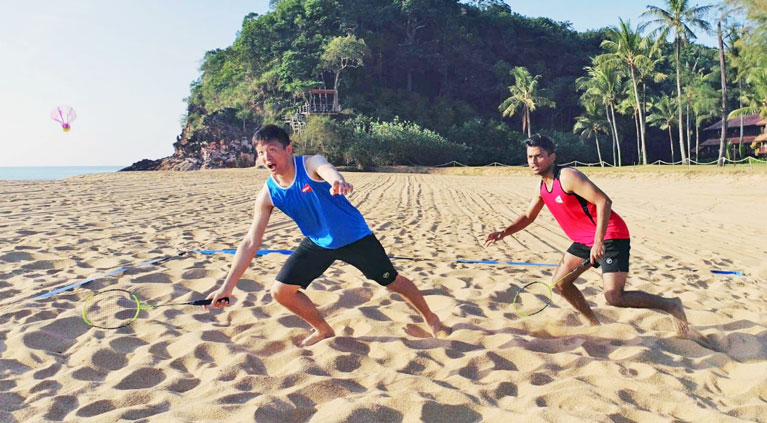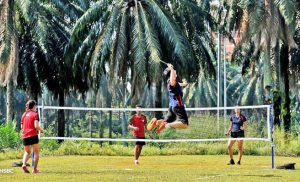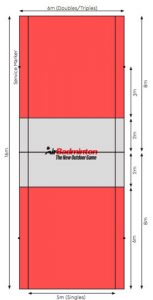AIRBADMINTON STARTER GUIDE RELEASED
Ready, set, play!

Players from member-associations of Badminton World Federation enjoy AirBadminton at a sand court. (Badminton Oceania)
Northern Marianas Badminton Association’s plan to introduce AirBadminton to the islands is moving forward as it received the “Getting Started” guide for the innovative game from Badminton Oceania.
The guidelines for introduction to AirBadminton cover information on the playing environment/venue, equipment, and rules. The game, which is played outdoor and is launched by Badminton World Federation last year, also utilizes drills taught in Shuttle Time.
“Given the diverse range of landscapes and stunning scenery offered across Oceania, the alternative version of the game is an exciting opportunity for players to get involved and enjoy the multiple health and social benefits of badminton,” Badminton Oceania said as it released the Getting Started” guide to its member-federations.
NMBA welcomed Badminton Oceania’s latest information campaign and NMBA president Merlie Tolentino said they will share the guidelines to their members, particularly those who will volunteer to introduce AirBadminton to schools.

A player leaps for a return during an AirBadminton game at a grass court. (Badminton World Federation)
NMBA had earlier said that the Public School System Athletic Department, which oversees sports competitions among schools in the CNMI, has reached out to the association for the possibility of including AirBadminton to the list of programs to be offered to students in the next school year.
What’s the setup?
Since AirBadminton is a new concept, Badminton Oceania is recommending to its member-federations to create a playing venue/environment that is convenient and safe for players.

Players compete in the doubles event during an AirBadminton game at a hard court. (Badminton World Federation)
AirBadminton can be played on grass, sand, or hard surface in parks, gardens, streets, and playgrounds. For safety, the surface should be leveled and uniformed and cleared from debris and other objects that may cause injuries to plays. For grass surfaces, it is advisable to play in dry areas to minimize incidents of players slipping.
With AirBadminton played in an outdoor setting, positioning of the court and considering the weather condition are important. According Badminton Oceania’s guidelines, the court “should be set up side on to the prevailing wind direction to allow for the best wind resistance.” As for the game-day weather, it’s best to play in a low-level wind or in overcast.
AirBadminton courts are longer than the indoor ones, 16-meters long compared to the latter’s 13.4m. Courts should be properly marked and posts must have appropriate height—1.55m from the surface of the court for grass and hard surfaces and 1.5 for sand.

Badmintonn Oceania presents the AirBadminton court diagram with measurements. (Badminton Oceania)
What do you need?
Players will need rackets and AirShuttle.
Rackets must have thicker strings since AirShuttle is heavier compared to the traditional shuttlecock, 8 grams to 5 grams. String tension should be between 17 lbs and 20 lbs.
Badminton Oceania has partnered with a private company—Victor—for the AirShuttle, a modified shuttlecock created with similar trajectory, acoustics, and play feel to that of a regular indoor shuttle, but with increased wind resistance (side and axial) since the game is played outdoors.
What are the rules?
As per BMF recommendations, for starters, AirBadminton can be played in a race to 11 points per game in a best-of-five setting. In case of a deadlock at 10-all, the first team/player to get a 2-point lead wins the game. For a tie at 12-all, the side that scores the 13th point takes the game. The winner of the game gets to serve first in the next match. Courts switch should be implemented after the leading player/team’s score reaches 6 points and at the end of each game.
Service is one of the basic shots in badminton and AirBadminton’s case, it shall be done anywhere behind the 3-meter marker on the sideline with both feet stationary. The served AirShuttle should land anywhere on the opposing side’s playing area, but must be beyond the 2-meter line. Underarm serve is a must.
AirBadminton has singles, doubles, and triples categories and for the last one, players are not allowed to make two consecutive returns.
“This rule creates more movement and increases the strategic element of the game,” according to Badminton Oceania.
Badminton Oceania encourages its member-federations to provide feedback on the “Getting Started” guide, specifically the usage of AirShuttle.























